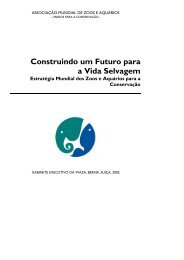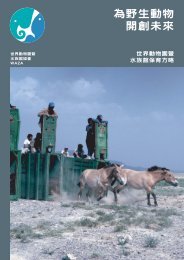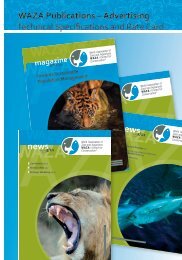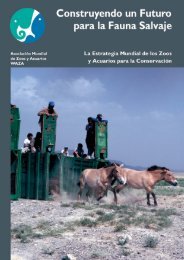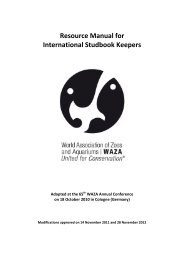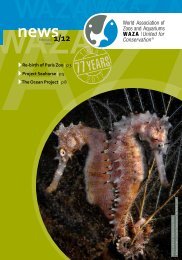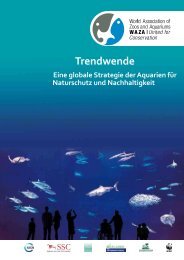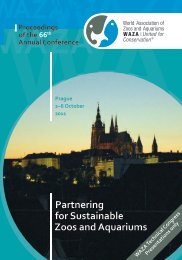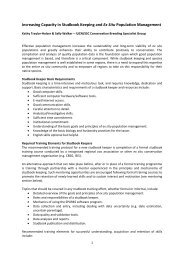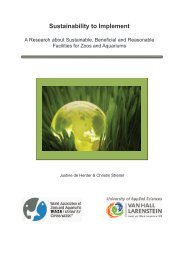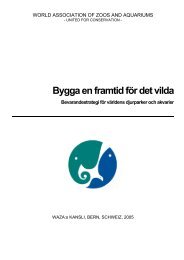Towards Sustainable Population Management - Waza
Towards Sustainable Population Management - Waza
Towards Sustainable Population Management - Waza
You also want an ePaper? Increase the reach of your titles
YUMPU automatically turns print PDFs into web optimized ePapers that Google loves.
WAZA magazine Vol 12/2011<br />
The revised “90%/100 Year” goal is<br />
now used regularly for population<br />
planning in conservation breeding<br />
programmes, although a majority of<br />
the officially recognised programmes<br />
do not have sufficient space to meet<br />
even this objective (Baker 2007; Lees<br />
& Wilcken 2009). Nevertheless, it is<br />
typically accepted as the standard towards<br />
which programmes strive. For<br />
example, AZA has even recently used<br />
it as a primary criterion upon which to<br />
base their new categorisation of their<br />
breeding programmes (e.g. “green”<br />
programmes are those that appear to<br />
be able to reach that goal). Thus, the<br />
goal of “90% for 100 Years” arguably<br />
seems to have become an operational<br />
definition of sustainability for<br />
captive populations.<br />
Genetic Sustainability<br />
of Captive <strong>Population</strong>s<br />
But is “90%/100 Year” really a sustainability<br />
goal? As Robert Lacy<br />
reminded us at a recent workshop<br />
on Intensively Managed <strong>Population</strong>s<br />
for Conservation in San Diego in<br />
December 2010, no, it is not. In fact,<br />
it is the opposite. Accepting a 10%<br />
loss and setting a timeframe of 100<br />
years are both counter to the concept<br />
of sustainability. Depending on the<br />
source, sustainable is defined as being<br />
able to be maintained at a certain<br />
rate or level or by avoiding depletion<br />
of a resource. Tolerating a 10% loss<br />
in the gene pool per century is hardly<br />
sustainable. And what happens in<br />
the year 2111, 100 years from now?<br />
Can we count on the technology to<br />
which Soulé et al. (1986) referred to<br />
be in place? Advances have not been<br />
as rapid as had been predicted. Thus,<br />
the “90%/100 Year” goal is certainly<br />
not a sustainability goal, but rather<br />
a goal that specifically allows for loss,<br />
acknowledging depletion.<br />
If the “90%/100 Year” goal is not a genetically<br />
sustainable goal, then what<br />
is? Conservation geneticists have<br />
debated this extensively (Frankham<br />
et al. 2010). With sustainability being<br />
defined as maintaining a population<br />
large enough so that genetic diversity<br />
is not depleted, then the population<br />
has to be large enough so that the<br />
rate of loss of gene diversity due to<br />
genetic drift (i.e. the random process<br />
of passing genes from parents to<br />
offspring, causing changes in gene<br />
frequencies between generations) is<br />
offset by the rate of increase in genetic<br />
diversity, added via mutations<br />
(the ultimate source of all genetic<br />
variation). Since mutation rates are<br />
very low (e.g. 10 -4 to 10 -5 per locus<br />
per generation for microsatellite<br />
loci; Frankham et al. 2010), the rate<br />
of loss due to genetic drift has to be<br />
correspondingly very low. And since<br />
genetic drift is inversely proportional<br />
to population size, the population<br />
sizes have to be very large.<br />
In genetics, population size is best<br />
expressed as an effective population<br />
size (N e ), defined as the number of<br />
individuals in an ideal population that<br />
loses genetic diversity at the same<br />
rate as the real population. An ideal<br />
population is a theoretical population<br />
that breeds randomly, and all animals<br />
can breed with each other and with<br />
themselves. It is a useful concept because<br />
we can accurately predict, using<br />
population genetics theory, how<br />
the genes in an ideal population will<br />
behave under varying conditions. To<br />
understand the genetics of real populations,<br />
we compare them to ideal<br />
populations. For example, if a population<br />
of 200 wombats loses genetic<br />
diversity at the same rate as an ideal<br />
population of size 52, then we say the<br />
effective size of the wombat population<br />
is 52. The wombat population<br />
is behaving like an ideal population<br />
of 52. So it is a population’s effective<br />
size that determines how it behaves<br />
genetically, not its actual census size.<br />
How N e is calculated is beyond the<br />
scope of this article, but N e can be estimated<br />
for most captive populations.<br />
Of particular interest is the ratio of<br />
a population’s effective size and its<br />
census size (N e /N), which allows one<br />
to calculate a population’s census size<br />
given its effective size, and vice versa.<br />
Genetics<br />
To return to the question of how<br />
large populations need to be to be<br />
genetically sustainable (i.e. suffer no<br />
loss of genetic diversity), the answer<br />
appears to be between N e of 500 and<br />
5,000 (Frankham et al. 2010). This is<br />
regardless of whether the population<br />
is in the wild or captivity. What does<br />
depend on whether the population is<br />
wild or captive is how its effective size<br />
translates into its census size. Wild<br />
populations are typically not managed<br />
genetically, have uneven sex ratios,<br />
fluctuate in size and have some<br />
breeders that produce more offspring<br />
than others, all of which decrease<br />
a population’s effective size. Estimates<br />
of effective sizes in wild populations<br />
are on the order of 10% of<br />
census size (N e /N = 0.11; Frankham et<br />
al. 2010). Thus, genetically sustainable<br />
wild populations need to be about<br />
ten times the effective size, or 5,000<br />
to 50,000 individuals. What about<br />
captive populations? Although no extensive<br />
surveys have been conducted,<br />
population management plans typically<br />
report N e /N as being between<br />
0.25 and 0.30 – much higher than wild<br />
populations, primarily because captive<br />
populations do not fluctuate in<br />
size as much as wild populations and,<br />
presumably, because of population<br />
management. Thus, to be genetically<br />
sustainable, captive populations need<br />
to be on the order of 1,700 to 20,000<br />
animals. Clearly this is not an option<br />
for the vast majority of species under<br />
conservation breeding and may be<br />
only possible for invertebrates and<br />
small vertebrates that can be housed<br />
en masse in breeding centres. Our<br />
captive facilities simply do not have<br />
the capacity to maintain genetically<br />
self-sustaining populations. For that<br />
matter, neither do many if not most<br />
wildlife reserves.<br />
21<br />
»



